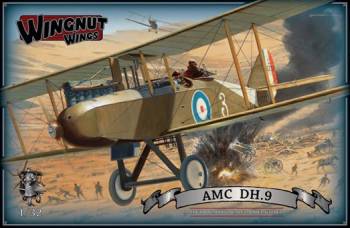The AMC DH.9 (Aircraft Manufacturing Company de Havilland design 9) bomber was intended to be an evolutionary successor to the highly regarded 275hp V12 Rolls Royce Eagle powered DH.4. Due to the existing and expected demand for Rolls Royce Eagle engines in the rapidly expanding RFC & RNAS the DH.9 was designed to be powered by the BHP (Beardmore-Halford-Pullinger) ‘straight 6’ engine which initially promised 300hp. The DH.9 utilized many proven components from the DH.4 such as wings, undercarriage, tailplane and basic fuselage design. Changes included moving the pilot rearwards for improved communication with the gunner, the petrol tank moved forward and the nose was redesigned to accommodate the new engine. It was intended to have a greater range than the DH.4 allowing it to bomb targets inside Germany. Alas it was not to be, and the DH.9 proved to be a great leap backwards.
As with so many Great War aircraft the tale of the DH.9, itself a highly competent design, is intrinsically linked to that of its engine. The BHP engine was put into mass production as the Siddeley-Deasy ‘Puma’ and never consistently achieved the promised 300hp, in actual fact its output was only 230hp and, to add insult to injury, it proved to be staggeringly unreliable. The 300hp BHP engine powered DH.9 prototype was converted from AMC built DH.4 A7559 and first flew in July 1917. The first production DH.9, Siddeley-Deasy powered AMC built C6059, took to the air in November 1917 and it was almost immediately clear that, because of the engine, performance was not going to surpass that of the DH.4. Nevertheless, the DH.9 was already in mass production with 11 different manufacturers, as was the flawed Puma engine, meaning that British bomber squadrons would now have to make do with it… or nothing at all. Although production orders for the DH.9 were placed in June 1917, engine and production delays meant that aircraft were not delivered in serious numbers until the end of 1917 but this situation gradually improved so that eventually a new DH.9 was completed every 40 minutes.
The first units to go into action with the DH.9 were 98, 206 and 211 Squadrons of the newly formed RAF in April 1918 at which time the shortcomings of the Puma engine immediately made themselves known. Broken valve springs, cracked cylinders and defective altitude controls on the carburetters lead to serious engine reliability problems which frequently required a hasty landing in German occupied territory. Towards the middle of 1918 the problems with the carburetters were overcome which markedly improved performance and finally allowed a fully loaded DH.9 to reach it’s intended ceiling of 15,500’. Several other improvements were made such as adding bracing struts under the horizontal tailplane, an additional magneto access door on the port side of the fuselage and extending the exhaust manifold to funnel the fumes away from the crew. Despite its numerous problems the DH.9 soldiered on until the Armistice and beyond, serving post war with the RAF on occupation duties in Germany as well as in Africa before being declared obsolete in 1921. It also saw widespread foreign service in The Netherlands, The Netherlands East Indies, Greece, Poland, Spain, Australia, New Zealand, India, Russia, Bolivia, Chile, Estonia, Ireland, Persia, Peru and South Africa as well as extensive civil use as a passenger aircraft. Any history here is of necessity very brief so we encourage you to seek out the references listed below for a more thorough understanding of this aircraft.
While there is little controversy about the common colour scheme of PC10 (Protective Covering number 10) for the upper surfaces and CDL (Clear Doped Linen) lower surfaces, there is a great deal of controversy as to what colour PC10 actually was. Made from mixes of yellow ochre, iron oxide and lamp black pigments it varied between olive drab and chocolate brown, depending on the mix. It appears that early, fresh PC10 appeared more olive drab while later mixes and aircraft exposed to the elements for some time would appear more chocolate brown. Plywood panels appear to have been painted Battleship Grey or with a PC10 equivelant paint as were the aluminium cowlings, although some were left unpainted. Interior metal brackets and fittings were usually painted black. Exterior metal brackets attached to the ply areas of the fuselage have also been noted as black but usually they were overpainted when the Battleship Grey or PC10 equivalent paint was applied. All fabric surfaces exhibited a gloss appearance when new which would weather to a semi-gloss or matt finish in service.
















